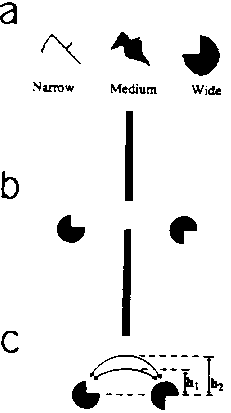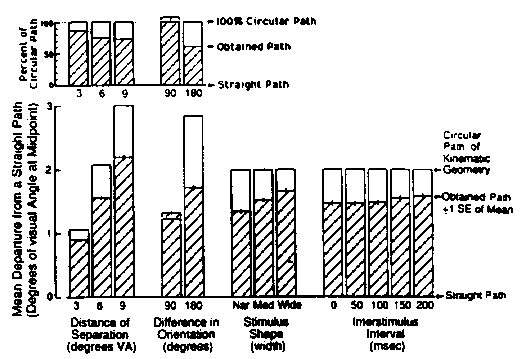Perception & Psychophysics 1989,
46(4), 333-337
Apparent Motion between shapes differing
in location and orientation: A window technique for estimating path curvature
Michael K. McBeath, Roger Shepard
When a shape is alternately presented in two positions
differing in both location and orientation, apparent motion tends to be
experienced over a curved path. The curvature provides evidence about principles
of object motion that may have been internalized in the perceptual system.
This study introduces a technique for estimating deviation from a straight
path. A shape was alternately presented on the two sides of a visual partition
with a "window" just wide enough to accommodate the shape. Observers
adjusted the location of the window to maximize the illusion of smooth
passage of the shape through the window. In accordance with theoretical
expectations, estimated deviations from rectilinear motion increased with
the separation between the stimuli in spatial location, angular orientation,
and time.
 |
Figure 1. Stimuli
used in the present experiment. (a) The three shapes differing in width
or elongation. (b) Layout of a visual display, showing two alternately
presented positions of a shape to the left and right of a vertical partition.
Observers adjusted the height of the window until the shape seemed to pass
most smoothly through it. (c) Schematic portrayal of curved paths of differing
height, h1 and h2. |
| Figure 2. Mean
departures of the center of the adjusted window above a straight path between
the centers of the two alternately presented stimuli. Each bar shows the
obtained departure for one level of one of the four independent variables.
The departure is averaged over all trials except those on which observers
gave the lowest confidence rating (i.e.,"1"). The total height
of each bar indicates the departure prescribed by kinematic geometry. The
height of the hatched portion indicates the obtained departure estimated
from the observers' adjustments of the window. The short vertical line
at the top of the shaded portion indicates +/- 1 standard error of that
obtained mean. In the upper left, the same data are replotted, for the
tested separations and angular differences, as a percentage of the heights
of the circular paths predicted by kinematic geometry. |
 |
Go to Top of Page
Go
to McBeath
Research Page
Go to McBeath
Home Page

